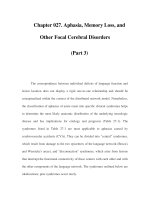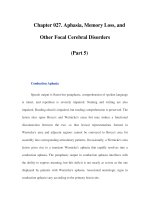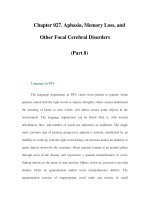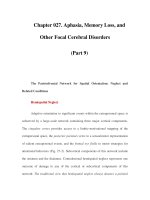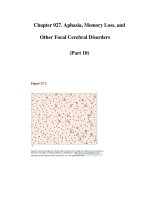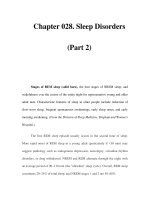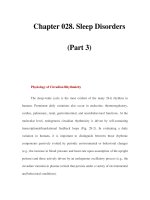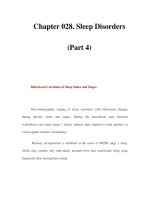Chapter 028. Sleep Disorders (Part 9) pot
Bạn đang xem bản rút gọn của tài liệu. Xem và tải ngay bản đầy đủ của tài liệu tại đây (41.8 KB, 5 trang )
Chapter 028. Sleep Disorders
(Part 9)
Restless Legs Syndrome (RLS)
Patients with this sensory-motor disorder report an irresistible urge to move
the legs, or sometimes the upper extremities, that is often associated with a creepy-
crawling or aching dysesthesias deep within the affected limbs. For most patients
with RLS, the dysesthesias and restlessness are much worse in the evening or
night compared to the daytime and frequently interfere with the ability to fall
asleep. The symptoms appear with inactivity and are temporarily relieved by
movement. In contrast, paresthesias secondary to peripheral neuropathy persist
with activity. The severity of this chronic disorder may wax and wane over time
and can be exacerbated by sleep deprivation, caffeine, alcohol, serotonergic
antidepressants, and pregnancy. The prevalence is 1–5% of young to middle-age
adults and 10–20% of those >60 years. There appear to be important differences in
RLS prevalence among racial groups, with higher prevalence in those of Northern
European ancestry. Roughly one-third of patients (particularly those with an early
age of onset) will have multiple affected family members. At least three separate
chromosomal loci have been identified in familial RLS, though no gene has been
identified to date. Iron deficiency and renal failure may cause RLS, which is then
considered secondary RLS. The symptoms of RLS are exquisitely sensitive to
dopaminergic drugs (e.g., pramipexole 0.25–0.5 mg q8PM or ropinirole 0.5–4.0
mg q8PM), which are the treatments of choice. Opiods, benzodiazepines, and
gabapentin may also be of therapeutic value. Most patients with restless legs also
experience periodic limb movements of sleep, although the reverse is not the case.
Periodic Limb Movement Disorder (PLMD)
Periodic limb movements of sleep (PLMS), previously known as nocturnal
myoclonus, consists of stereotyped, 0.5- to 5.0-s extensions of the great toe and
dorsiflexion of the foot, which recur every 20–40 s during NREM sleep, in
episodes lasting from minutes to hours, as documented by bilateral surface EMG
recordings of the anterior tibialis on polysomnography. PLMS is the principal
objective polysomnographic finding in 17% of patients with insomnia and 11% of
those with excessive daytime somnolence (Fig. 28-3). It is often unclear whether it
is an incidental finding or the cause of disturbed sleep. When deemed to be the
latter, PLMS is called PLMD. PLMS occurs in a wide variety of sleep disorders
(including narcolepsy, sleep apnea, REM sleep behavior disorder, and various
forms of insomnia) and may be associated with frequent arousals and an increased
number of sleep-stage transitions. The pathophysiology is not well understood,
though individuals with high spinal transections can exhibit periodic leg
movements during sleep, suggesting the existence of a spinal generator. Treatment
options include dopaminergic medications or benzodiazepines.
Figure 28-3
Polysomnographic recordings of (A) obstructive sleep apnea and (B)
periodic limb movement of sleep. Note the snoring and reduction in air flow in
the presence of continued respiratory effort, associated with the subsequent
oxygen desaturation (upper panel). Periodic limb movements occur with a
relatively constant intermovement interval and are associated with changes in the
EEG and heart rate acceleration (lower panel). Abbreviations: R.A.T., right
anterior tibialis; L.A.T., left anterior tibialis. (From the Division of Sleep
Medicine, Brigham and Women's Hospital.)
Evaluation of Daytime Sleepiness
Daytime impairment due to sleep loss may be difficult to quantify for
several reasons. First, sleepiness is not necessarily proportional to subjectively
assessed sleep deprivation. In obstructive sleep apnea, for example, the repeated
brief interruptions of sleep associated with resumption of respiration at the end of
apneic episodes result in daytime sleepiness, despite the fact that the patient may
be unaware of the sleep fragmentation. Second, subjective descriptions of waking
impairment vary from patient to patient. Patients may describe themselves as
"sleepy," "fatigued," or "tired" and may have a clear sense of the meaning of those
terms, while others may use the same terms to describe a completely different
condition. Third, sleepiness, particularly when profound, may affect judgment in a
manner analogous to ethanol, such that subjective awareness of the condition and
the consequent cognitive and motor impairment is reduced. Finally, patients may
be reluctant to admit that sleepiness is a problem, both because they are generally
unaware of what constitutes normal alertness and because sleepiness is generally
viewed pejoratively, ascribed more often to a deficit in motivation than to an
inadequately addressed physiologic sleep need.
